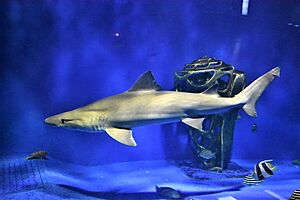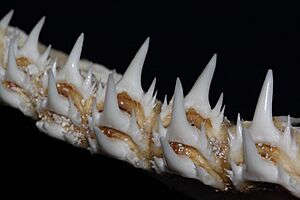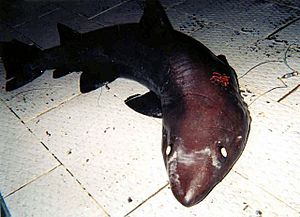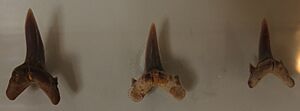Sand shark facts for kids
Quick facts for kids Sand sharks |
|
|---|---|
 |
|
| Smalltooth sand tiger (Odontaspis ferox) | |
| Scientific classification |
|
| Kingdom: | Animalia |
| Phylum: | Chordata |
| Class: | Chondrichthyes |
| Order: | Lamniformes |
| Family: | Odontaspididae J. P. Müller & Henle, 1839 |
| Type genus | |
| Odontaspis Agassiz, 1838
|
|
Sand sharks are a type of mackerel shark that belong to the family Odontaspididae. You can find them all over the world in both warm and mild (temperate) ocean waters. This shark family includes two living species in one main group, called a genus (Odontaspis). There are also several groups of sand sharks that are now extinct.
Contents
Amazing Sand Sharks
What Do Sand Sharks Look Like?
Sand sharks usually have a brown body. They often have darker spots on their upper half when they are young. These spots tend to fade away as the sharks grow older.
Their teeth are long, thin, and very sharp, like needles. These teeth are perfect for catching and holding onto fish, which is their favorite food. Each tooth has smooth edges and usually one or two smaller points on the sides. Sand sharks also have a large second dorsal fin, which is the fin on their back.
Where Do Sand Sharks Live?
The name "sand shark" comes from their habit of swimming close to shore. You can often see them near the ocean floor in areas where waves break, called the surf zone. Sometimes, they come very close to the beach!
These sharks prefer warm or mild waters. They live in oceans all around the world, but you won't find them in the eastern Pacific Ocean. They are also common in the Mediterranean Sea and the Adriatic Sea. They usually swim at depths from about 20 to 200 meters (65 to 650 feet) or even deeper.
How Do Sand Sharks Hunt and Behave?
Sand sharks have a very clever way of hunting. They can gulp air from the surface of the water. They then store this air in their stomach. This trick helps them float easily, making them very buoyant. Being buoyant allows them to sneak up on their prey almost without moving.
During the day, sand sharks are mostly quiet and don't move much. But when night comes, they become active and start hunting for food. Their main diet includes small fish. They also enjoy eating crustaceans (like crabs) and squid. Sometimes, they even hunt in groups, which are called "shivers" of sharks. They have even been known to try and get fish from full fishing nets.
The Sand Shark Life Cycle
Sand sharks have a unique way of reproducing. Inside their mother, only two embryos develop, one in each of her two uteri. The largest and strongest embryos grow by absorbing their less developed siblings while still inside the womb. This means only one pup is born from each uterus.
Because of this, sand sharks have one of the lowest reproduction rates among all sharks. This makes them very sensitive to any changes in their population. For this reason, they are listed as a vulnerable species. Many places protect them to help their numbers grow.
Are Sand Sharks Dangerous to People?
Sand sharks are generally not known to bite humans. If a person were to bother or provoke a sand shark, it might try to defend itself. However, these sharks are usually not aggressive.
Divers who go spearfishing might find sand sharks bothering them, but this is usually because of the fish they are carrying. In North America, divers often visit World War II shipwrecks. They enjoy swimming with the sand sharks that have made these wrecks their homes.
Protecting Sand Sharks
Scientists and conservation groups are working to protect sand sharks. A recent report from the PEW Charitable Trusts suggested new ways to manage and protect large animals that have seen their populations decrease.
Because sharks grow slowly and don't have many babies, traditional ways of managing fisheries might not be enough to help their populations recover. Stronger methods, similar to those used for large mammals, might be needed. These could include banning the keeping of the most vulnerable species and controlling international trade of sharks.
Types of Sand Sharks
The sand shark family (Odontaspididae) includes two living species. They both belong to the genus Odontaspis.
- Genus Odontaspis Agassiz 1838
- Odontaspis ferox A. Risso, 1810 (known as the smalltooth sand tiger)
- Odontaspis noronhai Maul, 1955 (known as the bigeye sand tiger)
For a long time, another shark called the sand tiger shark (from the genus Carcharias) was thought to be part of this group because they looked very similar. However, new scientific studies, especially looking at their mitochondrial DNA, showed that Carcharias is actually quite different. It's more distantly related to other sharks than Odontaspis is. Because of these discoveries, Carcharias was moved into its own separate family called Carchariidae.
Ancient Sand Sharks
Scientists have found fossils of many other sand shark relatives that lived long ago. Here are some of the ancient groups (genera) they have identified:
- Genus Striatolamia † Glikman, 1964
- Genus Carcharoides † Ameghino, 1901
- Genus Parodontaspis † White, 1931
- Genus Priodontaspis † Ameghino, 1901
- Genus Pseudoisurus † Glikman, 1957
- Genus Synodontaspis † White, 1931
- Subfamily Johnlonginae † Shimada, 2015
- Genus Johnlongia †
- Genus Pseudomegachasma † (Shimada, 2015)




